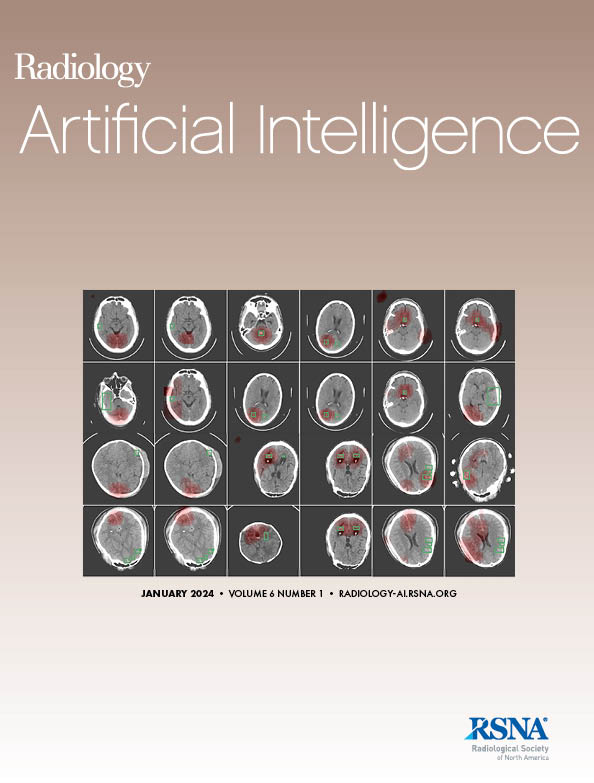Samantha P Zuckerman, Senthil Periaswamy, Julie L Shisler, Ameena Elahi, Christine E Edmonds, Jeffrey Hoffmeister, Emily F Conant
下载PDF
{"title":"Evaluating the Impact of Changes in Artificial Intelligence-derived Case Scores over Time on Digital Breast Tomosynthesis Screening Outcomes.","authors":"Samantha P Zuckerman, Senthil Periaswamy, Julie L Shisler, Ameena Elahi, Christine E Edmonds, Jeffrey Hoffmeister, Emily F Conant","doi":"10.1148/ryai.230597","DOIUrl":null,"url":null,"abstract":"<p><p>Purpose To evaluate the change in digital breast tomosynthesis artificial intelligence (DBT-AI) case scores over sequential screenings. Materials and Methods This retrospective review included 21 108 female patients (mean age ± SD, 58.1 years ± 11.5) with 31 741 DBT screening examinations performed at a single site from February 3, 2020, to September 12, 2022. Among 7000 patients with two or more DBT-AI screenings, 1799 had a 1-year follow-up and were included in the analysis. DBT-AI case scores and differences in case score over time were determined. Case scores ranged from 0 to 100. For each screening outcome (true positive [TP], false positive [FP], true negative [TN], false negative [FN]), mean and median case score change was calculated. Results The highest average case score was seen in TP examinations (average, 75; range, 7-100; <i>n</i> = 41), and the lowest average case score was seen in TN examinations (average, 34; range, 0-100; <i>n</i> = 1640). The largest positive case score change was seen in TP examinations (mean case score change, 21.1; median case score change, 17). FN examinations included mammographically occult cancers diagnosed following supplemental screening and those found at symptomatic diagnostic imaging. Differences between TP and TN mean case score change (<i>P</i> < .001) and between TP and FP mean case score change (<i>P</i> = .02) were statistically significant. Conclusion Using the combination of DBT AI case score with change in case score over time may help radiologists make recall decisions in DBT screening. All studies with high case score and/or case score changes should be carefully scrutinized to maximize screening performance. <b>Keywords:</b> Mammography, Breast, Computer Aided Diagnosis (CAD) <i>Supplemental material is available for this article.</i> © RSNA, 2025.</p>","PeriodicalId":29787,"journal":{"name":"Radiology-Artificial Intelligence","volume":" ","pages":"e230597"},"PeriodicalIF":13.2000,"publicationDate":"2025-02-01","publicationTypes":"Journal Article","fieldsOfStudy":null,"isOpenAccess":false,"openAccessPdf":"https://www.ncbi.nlm.nih.gov/pmc/articles/PMC11950889/pdf/","citationCount":"0","resultStr":null,"platform":"Semanticscholar","paperid":null,"PeriodicalName":"Radiology-Artificial Intelligence","FirstCategoryId":"1085","ListUrlMain":"https://doi.org/10.1148/ryai.230597","RegionNum":0,"RegionCategory":null,"ArticlePicture":[],"TitleCN":null,"AbstractTextCN":null,"PMCID":null,"EPubDate":"","PubModel":"","JCR":"Q1","JCRName":"COMPUTER SCIENCE, ARTIFICIAL INTELLIGENCE","Score":null,"Total":0}
引用次数: 0
引用
批量引用
Abstract
Purpose To evaluate the change in digital breast tomosynthesis artificial intelligence (DBT-AI) case scores over sequential screenings. Materials and Methods This retrospective review included 21 108 female patients (mean age ± SD, 58.1 years ± 11.5) with 31 741 DBT screening examinations performed at a single site from February 3, 2020, to September 12, 2022. Among 7000 patients with two or more DBT-AI screenings, 1799 had a 1-year follow-up and were included in the analysis. DBT-AI case scores and differences in case score over time were determined. Case scores ranged from 0 to 100. For each screening outcome (true positive [TP], false positive [FP], true negative [TN], false negative [FN]), mean and median case score change was calculated. Results The highest average case score was seen in TP examinations (average, 75; range, 7-100; n = 41), and the lowest average case score was seen in TN examinations (average, 34; range, 0-100; n = 1640). The largest positive case score change was seen in TP examinations (mean case score change, 21.1; median case score change, 17). FN examinations included mammographically occult cancers diagnosed following supplemental screening and those found at symptomatic diagnostic imaging. Differences between TP and TN mean case score change (P < .001) and between TP and FP mean case score change (P = .02) were statistically significant. Conclusion Using the combination of DBT AI case score with change in case score over time may help radiologists make recall decisions in DBT screening. All studies with high case score and/or case score changes should be carefully scrutinized to maximize screening performance. Keywords: Mammography, Breast, Computer Aided Diagnosis (CAD) Supplemental material is available for this article. © RSNA, 2025.
评估人工智能病例评分随时间推移的变化对数字乳腺断层合成筛查结果的影响。
“刚刚接受”的论文经过了全面的同行评审,并已被接受发表在《放射学:人工智能》杂志上。这篇文章将经过编辑,布局和校样审查,然后在其最终版本出版。请注意,在最终编辑文章的制作过程中,可能会发现可能影响内容的错误。目的评价连续筛查后DBT-AI(数字乳腺断层合成-人工智能)病例评分的变化。材料与方法本回顾性研究纳入21,108例女性患者(平均年龄58.1±[SD] 11.5岁),于2020年3月2日至2022年9月12日在单个部位进行了31,741次DBT筛查检查。在7000名接受两次或两次以上DBT-AI筛查的患者中,1799名患者进行了一年的随访,并被纳入分析。确定DBT-AI病例评分和病例评分随时间的差异。案例得分从0-100分不等。对于每个筛查结果(真阳性(TP)、假阳性(FP)、真阴性(TN)、假阴性(FN)),计算病例评分变化的平均值和中位数。结果TP检查平均病例评分最高(平均75分,范围7 ~ 100分,n = 41), TN检查平均病例评分最低(平均34分,范围0 ~ 100分,n = 1640)。TP检查阳性病例评分变化最大(平均病例评分变化21.1分,中位数病例评分变化17分)。FN检查包括在辅助筛查后诊断的乳腺x线摄影隐匿癌和在症状性诊断成像中发现的癌。TP与TN平均病例评分变化差异(P < 0.001), TP与FP平均病例评分变化差异(P = 0.02)均有统计学意义。结论结合DBT- ai病例评分与病例评分随时间的变化可以帮助放射科医生在DBT筛查中做出回忆决策。所有高病例评分和/或病例评分变化的研究都应仔细审查,以最大限度地提高筛查效果。©RSNA, 2025年。
本文章由计算机程序翻译,如有差异,请以英文原文为准。

 求助内容:
求助内容: 应助结果提醒方式:
应助结果提醒方式:


